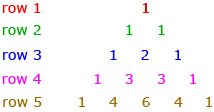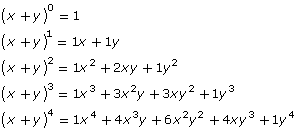Explore
In Try This 1 you may have noticed that expanding a binomial power by multiplying is a very tedious task, even for relatively small exponents. There are a variety of patterns that occur when you expand the expression (x + y)n. Some of these patterns include the following:
- The number of terms in the expansion is equal to n + 1. For example, (x + y)15 will have 16 terms.
- The exponent of x and the exponent of y in each term add up to n. For example, if n = 3, each pair of exponents in a term adds up to 3.
(x + y)3 = 1x3y0 + 3x2y1 + 3x1y2 + 1x0y3 - The exponents on the x in each term in the expansion will include n, n − 1, …, 2, 1, 0. For example, if n = 4
(x + y)4 = 1x4y0 + 4x3y1 + 6x2y2 + 4x1y3 + 1x0y4 - The exponents on the y in each term in the expansion will include n, n − 1, …, 2, 1, 0. For example, if n = 4
(x + y)4 = 1x4y0 + 4x3y1 + 6x2y2 + 4x1y3 + 1x0y4
The rest of this lesson focuses on these patterns, which help to make expanding a binomial easier. The pattern for the coefficients of the terms is a bit more elusive. You will explore this pattern using Pascal’s triangle in Try This 2.
Try This 2
The first five rows of Pascal’s triangle are shown.

- Examine the triangle. Describe at least three patterns you see.
- Determine rows 6 and 7.
- Recall the binomial powers that you expanded in Try This 1.

- Describe the relationship between the binomial expansions and Pascal’s triangle.
- Use Pascal’s triangle to predict the coefficients in the expansion of (x + y)6.

- Complete the expansion of (x + y)6.

- Predict the first four terms of the expansion of (x + y)10.
![]() Save your responses in your course folder.
Save your responses in your course folder.
Share 2
With a partner or group, discuss the following questions based on the patterns you determined in Try This 2.
- Compare the patterns you found in Pascal’s triangle. How did your strategy to determine the next rows compare with others?
- Compare the relationships you determined between Pascal’s triangle and binomial expansions.
- Explain why the strategy of writing out the rows of Pascal’s triangle may not be reasonable to determine the first four terms of (x + y)33.
![]() If required, save a record of your discussion in your course folder.
If required, save a record of your discussion in your course folder.